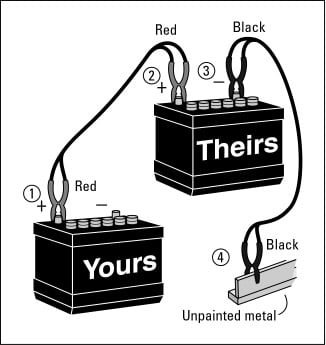Did you ever consider those wonderful days when your car won't start? If you left your lights, radio, or some other electrical gizmo on after you parked the car, you know what the trouble is: Your battery is dead. Of course, there are other possible reasons that your car won't start.
Won't-start symptoms
Your car may not start for a number of reasons. The following list outlines the most common circumstances and tells you what action you can take to try to remedy each situation:
- The car is silent when you turn the key in the ignition. Check the battery terminal cable connections. If they look very corroded, force the point of a screwdriver (with an insulated or wooden handle) between the connector and the terminal post and twist it to lodge it firmly. Then try to start the engine. If it starts, you need to clean or replace your cables.
- The car makes a clicking noise but won't start. This sound usually means a dead battery. If not, check the wiring to and from the starter for a loose connection.
- The car cranks over but won't start. Check the fuel supply to your engine. If that's okay, check whether the electrical spark is getting to your spark plugs.
- The engine starts but dies. If your car has a carburetor, check your carburetor adjustment and your choke to see whether the choke is first closing and then opening. If you have fuel injection, you'll need professional help.
- The car won't start on rainy days. Check inside the distributor cap for dampness. If you find moisture, get some mechanic's solvent from your friendly service station — they use it to clean car parts — or buy an aerosol can of it at an auto supply store. To evaporate any dampness inside the distributor cap, turn the cap upside down and pour or spray some solvent into it. Swish it around and pour it out. Then dry the cap as best you can with a clean, lint-free rag and replace the cap. Use only clean solvent; even a tiny speck of dirt can foul the points. Gasoline won't do because a spark can ignite gasoline fumes and cause an explosion or a fire.
- The car won't start on cold mornings. For vehicles with carburetors, check the choke. Is it closed? Does it open? If you have fuel injection, you'll need to have a professional diagnose the cold-start problems.
- The engine misses while idling. Check the points (if your car has a non-electronic distributor) and the spark plugs. Also check the fuel pump, fuel filter, and carburetor, if you have one.
- The engine misses or hesitates during acceleration. Check the accelerator pump in the carburetor (if equipped), the spark plugs, the distributor, and the timing.
- The engine knocks or pings. Check your timing; also check the octane rating of the fuel you're using. The owner's manual can tell you whether your vehicle needs regular unleaded or premium gasoline. Check the cooling system. Do a compression check on the engine cylinders.
How to jump-start a car
To safely jump-start a car, follow these steps:
1. Take out your jumper cables.
It's a good idea to buy a set of jumper cables and keep them in the trunk compartment. If you don't have jumper cables, you'll have to find a Good Samaritan who not only is willing to assist you but has jumper cables as well.
2. Place both cars in Park or Neutral, with their ignitions shut off and their emergency brakes on.
3. Remove the caps from both batteries (unless they're sealed).
Batteries produce explosive hydrogen gas, and a spark could set it off. If the caps are open, you can avoid such an explosion. (Sealed batteries have safety valves.)
4. Connect the cables.
The positive cable has red clips at either end, and the negative cable has black clips. It's important to attach them in the proper order:
1. First, attach one of the red clips to the positive terminal of your battery (it has "POS" or "+" on it, or it's bigger than the negative terminal).
2. Attach the other red clip to the positive terminal of the GS's car.
3. Attach one of the black clips to the negative terminal on the GS's battery.
4. Attach the last black clip to an unpainted metal surface on your car that isn't near the carburetor (if your car has one) or battery.
Figure 1 shows how both the positive and negative cables should be connected.
 |
|
Figure 1: Make sure to connect jumper cables in the proper order. |
5. Try to start your vehicle.
If it won't start, make sure that the cables are properly connected and have the GS run his or her engine for five minutes. Then try to start your car again. If it still won't start, your battery may be beyond help.
6. Disconnect the cables, thank the Good Samaritan, and resume your life.
Don't shut off your engine; drive around for a while to recharge your battery.
If your alternator light stays on or the gauge on the dashboard continues to point to "Discharge" after your car's been running, make sure that your fan belt is tight enough to run your alternator properly. If your battery keeps going dead, have a professional check both the battery and your alternator.
In any case, never drive around with a light or gauge that reads "Trouble"; have it checked out immediately — that's why those gauges are in there!






